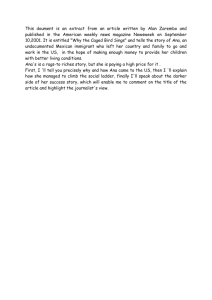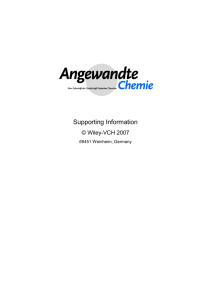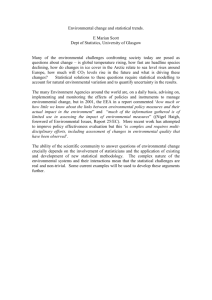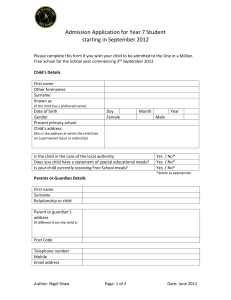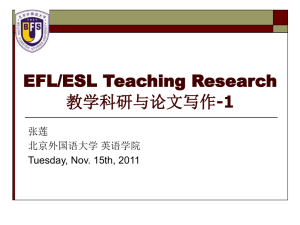Case study research design
advertisement
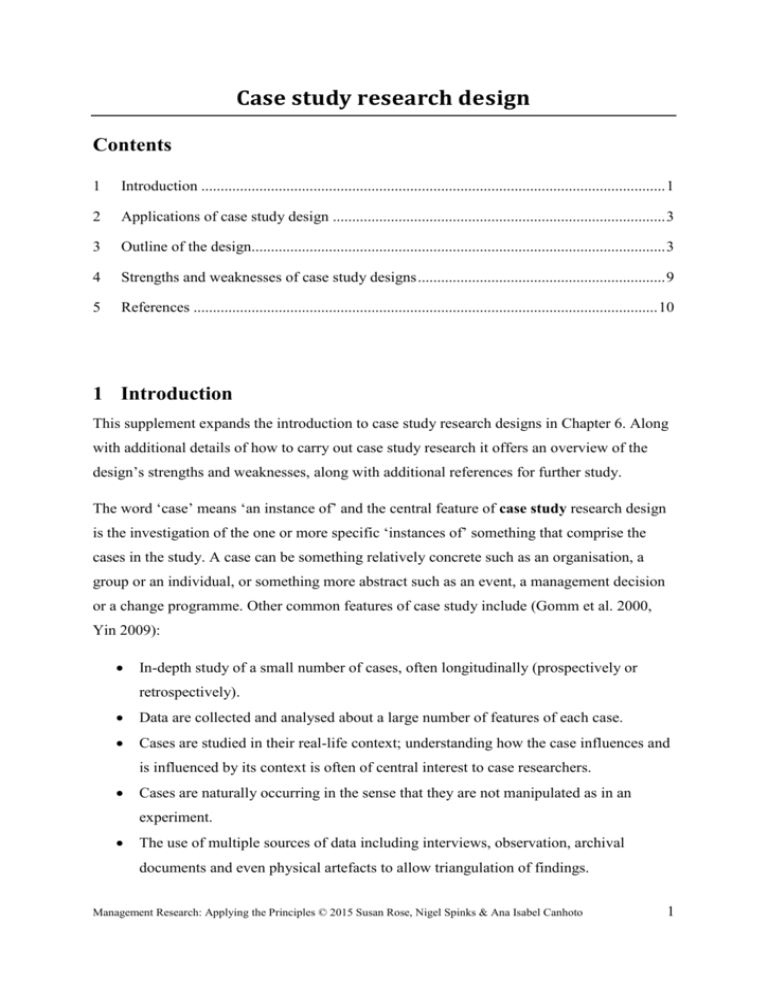
Case study research design Contents 1 Introduction ........................................................................................................................ 1 2 Applications of case study design ...................................................................................... 3 3 Outline of the design........................................................................................................... 3 4 Strengths and weaknesses of case study designs ................................................................ 9 5 References ........................................................................................................................ 10 1 Introduction This supplement expands the introduction to case study research designs in Chapter 6. Along with additional details of how to carry out case study research it offers an overview of the design’s strengths and weaknesses, along with additional references for further study. The word ‘case’ means ‘an instance of’ and the central feature of case study research design is the investigation of the one or more specific ‘instances of’ something that comprise the cases in the study. A case can be something relatively concrete such as an organisation, a group or an individual, or something more abstract such as an event, a management decision or a change programme. Other common features of case study include (Gomm et al. 2000, Yin 2009): In-depth study of a small number of cases, often longitudinally (prospectively or retrospectively). Data are collected and analysed about a large number of features of each case. Cases are studied in their real-life context; understanding how the case influences and is influenced by its context is often of central interest to case researchers. Cases are naturally occurring in the sense that they are not manipulated as in an experiment. The use of multiple sources of data including interviews, observation, archival documents and even physical artefacts to allow triangulation of findings. Management Research: Applying the Principles © 2015 Susan Rose, Nigel Spinks & Ana Isabel Canhoto 1 Case studies are most commonly associated with qualitative research and qualitative data but this need not be so and quantitative data can readily be incorporated into a case study where appropriate. A brief comment is needed on the topic of case studies in teaching since they are so widely used in business and management education. It is important to realise that academic case study research serves a different purpose. Teaching cases are written to highlight particular issues for teaching and to stimulate debate in class. Research case studies also differ from the short, descriptive ‘vignettes’ popular in textbooks and many policy reports. The case study method in research demands a high degree of depth, breadth and rigour, with careful attention to showing the way in which evidence supports the conclusions reached. Table 1 – Example case studies (based on Eisenhardt 1989: 535) Study Number and Research topic Data sources description of cases Burgelman (1983) 6 internal corporate Management of new Archives ventures in 1 major ventures Interviews corporation Some observation Mintzberg and 1 Longitudinal analysis Strategy formulation in Archives McHugh (1985) National Film Board of an adhocracy Some interviews 20 new product and Core capabilities and Interviews process development core rigidities in new Archives projects across 5 product development Canada 1939–75 Leonard-Barton (1992) companies Wilson et al. (2002) 5 projects in 5 Success factors in different companies implementing Interviews customer relationship management systems Olsson et al. (2008) 2 companies engaged Client–vendor Interviews in offshoring relationships in two- Workshops with stage offshoring practitioners from case companies Management Research: Applying the Principles © 2015 Susan Rose, Nigel Spinks & Ana Isabel Canhoto 2 Study Number and Research topic Data sources description of cases Ozcan and Eisenhardt 6 entrepreneurial firms The origins of alliance Archives (2009) in the same industry portfolios Interviews Industry conferences Some observation 2 Applications of case study design Case studies have been used in many different areas of management research including strategy, information systems, innovation and organisational change, reflecting the versatility of the design. Their ability to investigate cases in depth and to employ multiple sources of evidence makes them a useful tool for descriptive research studies where the focus is on a specific situation or context where generalisability is less important and in applied research, for example in describing the implementation of a programme or policy. It is in answers to ‘how’ and ‘why’ questions, however, that case study research comes into its own (Yin 1998), for both theory building and theory testing. In explanatory research, for instance, case studies offer the possibility of investigating causal mechanisms and the specific contexts in which they are activated (George and Bennet 2005). Case study research can also facilitate a holistic perspective on causality because it treats the case as a specific whole. It thereby offers the possibility of investigating causal complexity where there are many relevant factors but few observations. Case studies can also be used to research questions about process because the use of multiple data sources supports the retrospective investigation of events. A flavour of the diversity of case study topics is given by the different examples shown in Table 1. 3 Outline of the design Figure 1 illustrates the general steps in case study research to help you formulate your own research design. A multiple case study design is shown but similar steps apply to single case designs. Management Research: Applying the Principles © 2015 Susan Rose, Nigel Spinks & Ana Isabel Canhoto 3 Figure 1 – study research Steps in a multiple case design Design begins with formulating appropriate research questions that will shape the structure of the study to come. At this stage you should clearly define what the ‘cases’ in your case study will be, for example whether they are individuals, organisations, events and so on. Your cases form the unit of analysis for your study (Yin 2009). Your research questions should also make it clear what aspects of the cases are of interest; it will not be feasible to investigate every aspect of your chosen cases. Design also involves engaging with existing theory and Yin (2009) argues that this is one of the differences between case study research and designs like ethnography and grounded theory. In practice the degree of formal theorising will vary so we have called this step ‘thematising’, borrowing the term from Kvale and Brinkmann (2009: 106) to recognise that prior theory may be used in various ways in case study research. Although some studies involve deductive theory testing, many case studies take a more inductive or abductive approach. In such situations, Walsham (1995) suggests that theory is commonly used in one of three ways in case study research: As an initial guide to design and data collection, to create a theoretical framework which takes account of existing knowledge in the area. Management Research: Applying the Principles © 2015 Susan Rose, Nigel Spinks & Ana Isabel Canhoto 4 As part of an iterative process of data collection and analysis, with theoretical understandings being modified in the light of findings from the data. As a final product of the research. 3.1 Selecting cases Case selection involves two linked decisions: what cases and how many cases to study. One of the more controversial design issues in case study research is whether or not a single case is sufficient. Objections to single case research can arise from concerns about the representativeness of the chosen case, the extent to which generalisability is possible and the vulnerability to confirmation bias, the tendency for the collection or analysis of data to be biased so as to confirm the researcher’s preconceived opinion. This may be a particular risk if you are doing your case study on your own organisation. It is also difficult to carry out comparative analysis with a single case study. Yin (2009) suggests that there are five reasons for a single case design, namely that the case is critical in some way (e.g. in theory testing), that it is either unique or typical, that it is revelatory (previously inaccessible to researchers) or that the study is longitudinal, comparing the case at different points in time. Nevertheless it is probably wise to heed Remenyi et al.’s (1998) warning that a single case design is a risky option for business and management researchers. In applied research, the situation may be different because the focus is on a specific situation, but concerns about a single case may still apply. The alternative is to use multiple cases, the findings from which may be considered more compelling and robust. Multiple cases can allow theory to be better grounded in more varied evidence, with the particular advantage that they allow for cross-case comparison. Another option is to adopt an ‘embedded’ research design, wherein attention is given to sub-units within a single case (Yin 2009: 50). For example, the case study might be of a single organisational change programme, but could analyse the experience of individual projects within the overall programme. The projects therefore become the unit of analysis for the research. Whether such an approach is appropriate will depend upon your particular research questions. As well as how many cases to include, you will also have to decide which particular ones you are going to study. Where only one case is being selected, the criteria should be aligned with the reasons for choosing a single case study design that we discussed earlier. For multiple case studies the main criterion should be how the set of cases will contribute to theory testing Management Research: Applying the Principles © 2015 Susan Rose, Nigel Spinks & Ana Isabel Canhoto 5 or development, for example by seeking to replicate the study, to extend the domain to which the theory has been applied, or to rule out alternative explanations. In explanatory multiple case studies, Berg-Schlosser et al. (2009) suggest selecting cases based on the outcome but including cases with both positive and negative outcomes to facilitate comparison. A multiple case study looking at factors affecting merger success, for example, might select both successful and unsuccessful mergers for comparison. Similar considerations are relevant if you are carrying out applied research, although your initial choice of case(s) is likely to be determined by the location of the problem or issue you are investigating. Additional cases can then be chosen to allow comparison with the focal case. In choosing your cases you will also have to think about the practicalities of negotiating and maintaining access. This can be a problem in case study research because of the need to research the case in depth and access multiple sources of evidence. As with ethnography, you may need to find a sponsor or gatekeeper who can help you to identify potential interviewees, to locate documents and other material, and generally to get access to the data you need. Be aware, however, that you will also have to manage your relationship with your sponsor and that their sponsorship may affect how you are received by others in the organisation. In any event you will also need to identify key stakeholders in the research sites and develop an understanding of the politics of the organisations you are researching. 3.2 Preparing a case study protocol Before starting your field research, you should prepare a case study protocol. This is a written statement of what you are trying to achieve and how you are planning to achieve it; it serves in effect as a project plan for your case study fieldwork. In particular, the case study protocol should provide a clear link between your research questions, the data needed to answer those questions, and your plan for collecting and analysing that data. Preparing the protocol should allow you to anticipate potential problems in the proposed research so that you can devise strategies in advance for dealing with them. The aim is to facilitate systematic data collection across the different data sources, whilst still allowing flexibility to respond to emerging issues during fieldwork. A case protocol will be especially useful in team-based research projects to help coordinate activities within the team, especially if collecting data at different sites. Typical headings for a case study protocol are shown in Table 2. Management Research: Applying the Principles © 2015 Susan Rose, Nigel Spinks & Ana Isabel Canhoto 6 Table 2 – Case study protocol topics (based on Remenyi et al. 1998, and Yin 2009) Topic Contents Overview A statement of the overall aims of the research. Field procedures The procedures to be adopted during the field research, including how to gain access, how to capture data, time plan for data collection, etc. for each case. Research questions The specific research questions should be stated, including clear links to the theory/literature where appropriate. Data collection matrix A matrix (table) can be used to show the types of evidence to be collected, along with their relationships to each other and to the research questions identified above. Data analysis and case study How you will analyse individual cases, conduct cross-case reports analysis and create the case study reports. Before you start on the main cases, Yin (2009) recommends carrying out a pilot study to explore both substantive topic and method issues. Although such a study will not always be feasible, it can help to sharpen the focus of your research as well as ensure that your intended field procedures are effective. 3.3 Data collection Data collection for the individual case studies follows those rules and guidelines for collecting data relevant to each of the types of data to be used (see Chapters 10 to 12). Especially if researching multiple cases, you should try to use a uniform way of recording data since this will help with both analysis and reliability. You should also set up a case study database to manage the evidence that is collected, whether this evidence is in electronic or paper format. The database can also act as a repository for your own emerging ideas, for example initial thoughts on possible answers to the research question. Analysis can proceed iteratively with data collection, although you should be careful to avoid ‘premature closure’ by reaching conclusions too early without thorough evaluation of all of the data (Hartley 2004). If the study involves multiple cases, cross-case analysis can be carried out once the analysis of individual cases is completed. A range of data analysis techniques can be used as we discuss in Chapter 14. Management Research: Applying the Principles © 2015 Susan Rose, Nigel Spinks & Ana Isabel Canhoto 7 Finally, as with any other research design, you must present your findings and conclusions to your study. When writing your report, a particular issue for case study researchers is how much description and narrative to include for each case versus how much space to devote to analysis. As Hartley explains: ‘A mistake in writing up case studies is to believe that the narrative is the most interesting aspect of the study. Narrative alone is unlikely to be of interest to those outside the organisation [studied] and every effort has to be made to draw out the wider implications of the study.’ Hartley (2004: 330) Options for describing individual cases include chronological ordering, focusing on a key or critical event, or developing the description around an analytical framework (e.g. derived from your literature review). When writing up multiple cases you can consider describing cases separately or, alternatively, in the form of a cross-case analysis. Tabular presentation, summarising key features of each case, can also be useful. Remember, however, that in most business research the emphasis should be on analysis and interpretation and a case study is no exception. Research in practice 7.3 gives an example of multiple case study research. Research in practice 1 – Example case study Success factors for implementing customer relationship management systems Wilson et al. (2002) used a multiple case study to investigate how to ensure the successful implementation of an IT-enabled CRM (Customer Relationship Management) system. Drawing on existing literature, the authors identified a range of (potential) success factors which were to be tested in the research. ‘But,’ they noted, ‘we did not wish to exclude the possibility that the factors might need modification, or that additional factors might emerge, given the evolving nature of this application area and the relatively sparse previous research’ (Wilson et al. 2002: 202). They therefore wanted a research design that could combine elements of theory testing and theory generation. Five examples of CRM implementations were selected to provide variation in the industry sector, the nature of the CRM application and the perceived project success. Primary data collection was by qualitative interview with a total of 23 managers being interviewed. The success factor framework was compared against each case in turn and developed progressively during the analysis using a Management Research: Applying the Principles © 2015 Susan Rose, Nigel Spinks & Ana Isabel Canhoto 8 process known as analytic induction. Each factor was weighted according to its presence and influence and the whole then summarised in a summary table. The authors then drew conclusions on success factors and their relative impact. 4 Strengths and weaknesses of case study designs One of the greatest strengths of the case study design is its adaptability to different types of research question and to different research settings. The use of multiple sources of evidence allows triangulation of findings which, according to Yin (2009), is a major strength of the case study design. Case studies also offer the benefit of studying phenomena in detail and in context, particularly in situations where there are many more variables of interest than there are observations. Another potential advantage of case studies is that the format may make the research accessible to wider readership than some other designs. In the context of information systems research, for example, Dubé and Paré (2003) argue that case studies can help academics and practitioners keep up with a fast-changing field whilst Eisenhardt and Graebner (2007: 25) claim that ‘papers that build theory from cases are among the most highly cited pieces in [the Academy of Management Journal]…, with impact disproportionate to their numbers’. Nevertheless, case study research has its limitations. One technical issue is a variant of what is known as selection bias whereby the choice of cases biases the findings of the research, particularly with respect to excluding cases that contradict favoured theory. Another concern raised is generalisability, particularly of single case studies. Certainly, if the research findings need to be generalised statistically then a case study approach is not suitable although other forms of generalisation may be employed as discussed in Chapter 4. A further concern about case study design is that since neither experimental nor statistical controls can be used in case study research, internal validity (at least as it is understood in quantitative research) may be hard to establish. Many of these concerns apply to qualitative research more broadly and it is important when evaluating case study research not to interpret them exclusively through the ‘prism of statistical methods’ (George and Bennet 2005: 22). A final limitation, or more accurately a practical challenge, of case study research is that it can be very demanding to carry out. One reason for this is the need for in-depth access to case sites. Another is the requirement it places on the researcher in terms of dealing with the complexity of field research if multiple data collection methods are used. Management Research: Applying the Principles © 2015 Susan Rose, Nigel Spinks & Ana Isabel Canhoto 9 5 References Berg-Schlosser, D., De Meur, G., Rihoux, B. and Ragin, C. C. (2009). Qualitative comparative analysis (QCA) as an approach. In: Rihoux, B. and Ragin, C. C. (eds.) Configurational comparative methods. Thousand Oaks, CA: Sage. Burgelman, R. A. (1983). ‘A process model of internal corporate venturing in the diversified major firm’, Administrative Science Quarterly, 28(2), 223–244. Dubé, L. and Paré, G. (2003). ‘Rigor in information systems postive case research: Current practices, trends and recommendations’, MIS Quarterly, 27(4), 597–635. Eisenhardt, K. M. (1989). ‘Building theories from case study research’, Academy of Management Review, 14(4), 532–550. Eisenhardt, K. M. and Graebner, M. E. (2007). ‘Theory building from cases: Opportunities and challenges’, Academy of Management Journal, 50(1), 25–32. George, A. L. and Bennet, A. (2005). Case studies and theory development in the social sciences. Cambridge, MA: The MIT Press. Gomm, R., Hammersley, M. and Foster, P., (eds.) (2000). Case study method. London: Sage. Hartley, J. (2004). Case study research. In: Cassell, C. and Symon, G. (eds.) Essential guide to qualitative methods in organizational research. London: Sage. Kvale, S. and Brinkmann, S. (2009). Interviews. Thousand Oaks, CA: Sage. Leonard-Barton, D. (1992). ‘Core capabilities and core rigidities: A paradox in managing new product development’, Strategic Management Journal, 13(S1), 111–125. Mintzberg, H. and McHugh, A. (1985). ‘Strategy formation in an adhocracy’, Administrative Science Quarterly, 30(2), 160–197. Olsson, H. H., Ó Conchúir, E., Ågerfalk, P. J. and Fitzgerald, B. (2008). ‘Two-stage offshoring: An investigation of the Irish bridge’, MIS Quarterly, 32(2), 257–279. Ozcan, P. and Eisenhardt, K. M. (2009). ‘Origin of alliance portfolios: Entrepreneurs, network strategies and firm performance’, Academy of Management Journal, 52(2), 246–279. Remenyi, D., Williams, B., Money, A. and Swartz, E. (1998). Doing research in business and management. An introduction to process and method. London: Sage. Walsham, G. (1995). ‘Interpretive case studies in IS research: Nature and method’, European Journal of Information Systems, 4(2), 74–81. Management Research: Applying the Principles © 2015 Susan Rose, Nigel Spinks & Ana Isabel Canhoto 10 Wilson, H., Daniel, E. and McDonald, M. (2002). ‘Factors for success in customer relationship management (CRM) systems’, Journal of Marketing Management, 18(1), 193–219. Yin, R. K. (1998). The abridged version of case study research: Design and method. In: Bickman, L. and Rog, D. J. (eds.) Handbook of applied social research methods. Thousand Oaks, CA: Sage. Yin, R. K. (2009). Doing case study research. 4th ed. Thousand Oaks, CA: Sage. Management Research: Applying the Principles © 2015 Susan Rose, Nigel Spinks & Ana Isabel Canhoto 11

